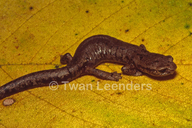|
Bolitoglossa heiroreias Greenbaum, 2004
Holy-Mountain Salamander, Salamandra de Montecristo, Salamandra del Cerro Montecristo Subgenus: Magnadigita | family: Plethodontidae subfamily: Hemidactyliinae genus: Bolitoglossa |
| Species Description: Greenbaum, E. 2004. A new species of Bolitoglossa (Amphibia: Caudata: Plethodontidae) from montane forests in Guatemala and El Salvador. J. Herpetol 38:411-421 | |
 © 2007 Twan Leenders (1 of 6) |
|
|
|
Description Relative to other members of the genus Bolitoglossa, B. heiroreias is a medium-sized, dull-colored species with well-developed subdigital pads, bluntly rounded toe tips, a single phalanx of the largest toe without webbing, 1.5–2.0 phalanges of forelimb Digit III free of webbing, first caudal vertebrae with branched (bifurcated) transverse processes (sensu Wake and Dresner, 1967), relative lengths of digits on forelimbs (I < IV < II < III), and a prominent mental gland in males. Both sexes have a dorsal color of dark gray, dull brown, or black with gray lichenous blotches or black blotches; Leenders and Watkins-Colwell (2004) noted overall coloration is relatively darker at night compared to the day. Males have a maximum SVL of 44.9 mm and are relatively slender, whereas the maximum size for relatively robust females (holotype) is 63.1 mm. Adult males have a truncated (blunt) snout in dorsal aspect, and females and juveniles have a broadly rounded snout. Distribution and Habitat Country distribution from AmphibiaWeb's database: El Salvador, Guatemala, Honduras
Life History, Abundance, Activity, and Special Behaviors Specimens of this species were collected on or under logs or rotting wood, in bromeliads, on vegetation, and in the humus between roots of terrestrial bromeliads. One specimen was regurgitated by a Rhadinaea montecristi (Serpentes: Colubridae) and one individual was found dead at the bottom of an artificial pond during the day with lacerations consistent with peck marks by a large bird, suggesting avian predation on this species (Greenbaum, 2004). Leenders and Watkins-Colwell (2004) suggested this species might be arboreal at night and use terrestrial retreats during the day. Trends and Threats Although population data are not available for this species, the small extent of occurrence satisfies the Endangered Criterion B1ab(iii) of the IUCN Red List (IUCN, 2001). Greenbaum and Komar (in press) classified this species as critically endangered at the national level in El Salvador. Extensive areas of lowland forest surrounding the Sierra de Metapán range have been destroyed, which increases the likelihood of reduced humidity in the habitats where Bolitoglossa heiroreias occurs (Lawton et al., 2001). Currently, only the El Salvador side of the mountain range has an established national park (Parque Nacional Montecristo). Comments Bolitoglossa heiroreias is a member of the B. dunni group (sensu Parra-Olea et al., 2004), and forms a clade with B. celaque (Honduras) and B. synoria (El Salvador and Honduras). Bolitoglossa heiroreias is readily distinguished from B. celaque by dorsal coloration and from B. synoria by foot morphology (Greenbaum, 2004). The remaining two species of salamander in El Salvador, B. salvinii and Oedipina taylori, occur at low to mid elevations (< 1200 m) in dry forest habitats (Köhler et al., in press). References Greenbaum, E. 2004. A new species of Bolitoglossa (Amphibia: Caudata: Plethodontidae) from montane forests in Guatemala and El Salvador. 38:411–421. Greenbaum, E., and O. Komar. In press. Threat assessment and conservation prioritization of the herpetofauna of El Salvador. Biodiversity and Conservation IUCN. 2001. IUCN Red List Categories, Version 3.1. Prepared by the IUCN Species Survival Commission. IUCN, Gland, Switzerland. Köhler, G., M. Vesely, and E. Greenbaum. In press. The Amphibians and Reptiles of El Salvador. Krieger Publishing Company, Melbourne, FL. Lawton, R. O., U. S. Nair, R. A. Pielke Sr., and R. M. Welch. 2001. Climatic impact of tropical lowland deforestation on nearby montane cloud forests. Science 294:584–587. Leenders, T. A. A. M., and G. J. Watkins-Colwell. 2004. Notes on a collection of amphibians and reptiles from El Salvador. Postilla 231:1–31. Parra-Olea, G., M. García-París, and D. B. Wake. 2004. Molecular diversification of salamanders of the tropical American genus Bolitoglossa (Caudata: Plethodontidae) and its evolutionary and biogeographic implications. Biological Journal of the Linnean Society 81:325–346. Wake, D. B., and I. G. Dresner. 1967. Functional morphology and evolution of tail autotomy in salamanders. Journal of Morphology 122:265–306. Originally submitted by: Eli Greenbaum and Twan Leeders (first posted 2005-03-06) Edited by: Tate Tunstall (2005-03-07) Species Account Citation: AmphibiaWeb 2005 Bolitoglossa heiroreias: Holy-Mountain Salamander <https://amphibiaweb.org/species/6343> University of California, Berkeley, CA, USA. Accessed Nov 4, 2024.
Feedback or comments about this page.
Citation: AmphibiaWeb. 2024. <https://amphibiaweb.org> University of California, Berkeley, CA, USA. Accessed 4 Nov 2024. AmphibiaWeb's policy on data use. |



 Raffaëlli Account
Raffaëlli Account Map of Life
Map of Life